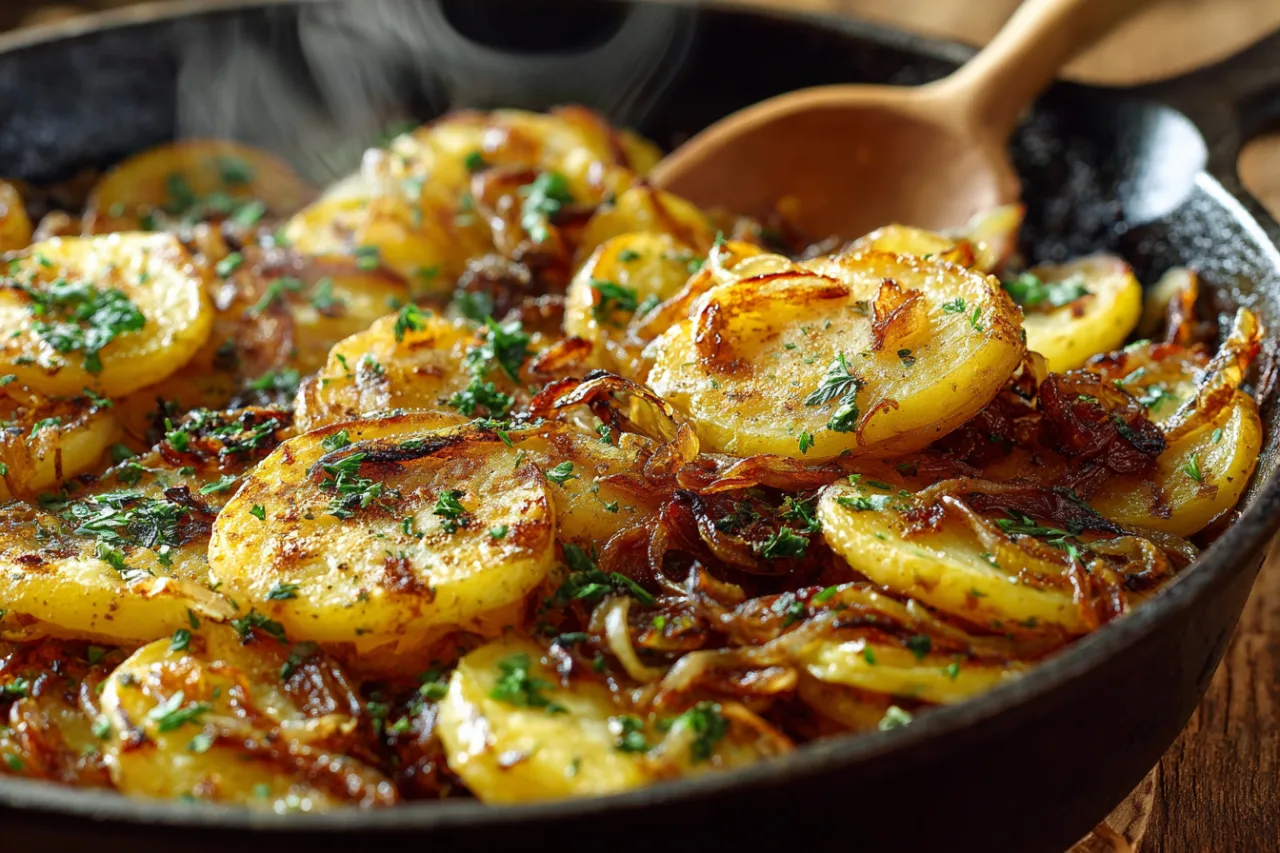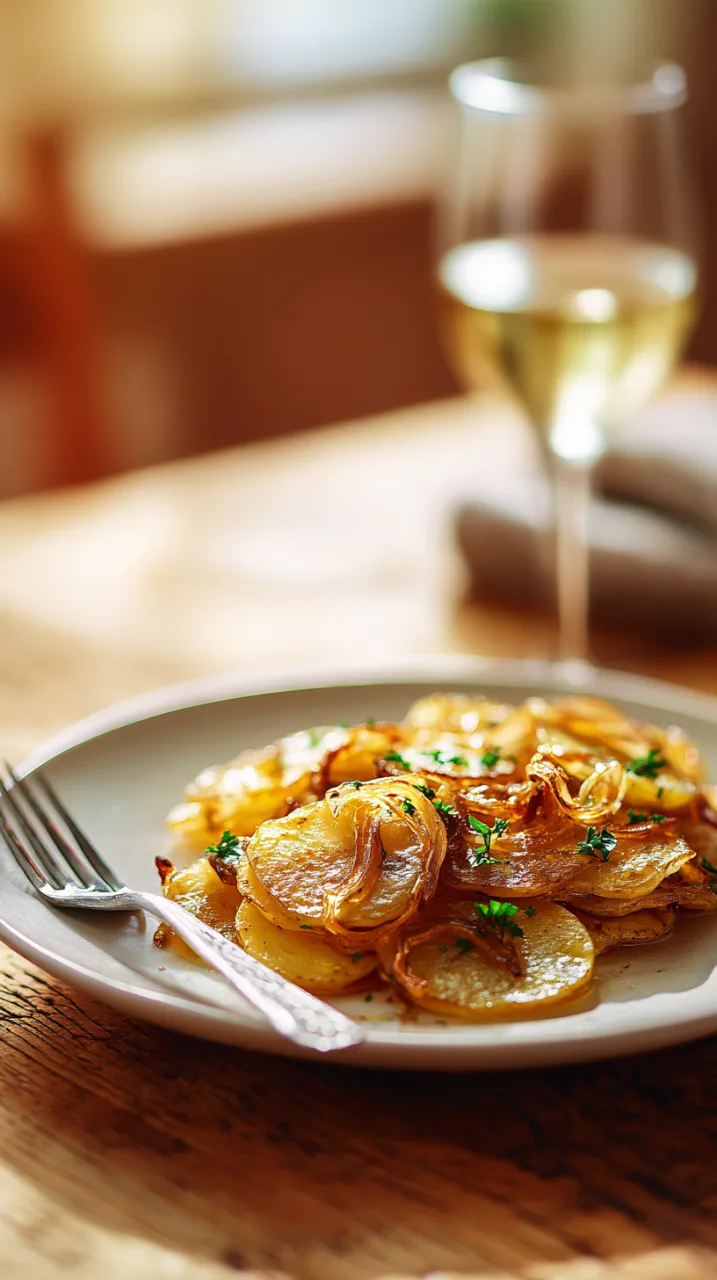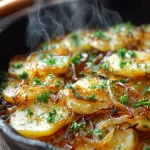Lyonnaise Potatoes Recipe That Outsmarts Mashed Every Time
I’ve cooked more potatoes than I can count. I’ve mashed them for a hundred weddings, roasted them by the sheet pan for college kids who ate like wolves, stacked them in gratin dishes heavier than toddlers. Some came out perfect. Plenty… not so much. And nothing stings like watching a tray of mashed potatoes sit half full while the bread basket disappears.
That’s why I keep coming back to Lyonnaise potatoes. These little rounds don’t get ignored. Crispy on the outside, creamy in the middle, onions melting into sweet ribbons, parsley cutting through. You hear that faint pop of butter in cast iron, smell it drift across the kitchen, and suddenly the line of students stops talking. Forks go down, heads turn. Potatoes did that.
Serve these Lyonnaise potatoes alongside juicy herb-roasted chicken thighs for a dinner that feels like a bistro classic at home.
Why These Potatoes Refuse to Fade
Mashed is safe. Scalloped is rich. Both can end up background noise. Lyonnaise? No chance. They demand attention. They hit the table with color and crunch.
I remember a holiday catering dinner… long tables in a Santa Cruz hall, candles down the middle, roast chickens coming out hot.
We set two trays: mashed on one side, Lyonnaise on the other. By dessert, mashed was still sitting there, half cold.
The Lyonnaise pan? Scraped down to fond, a couple of crispy bits left stuck to the bottom. Folks were sneaking second helpings while servers pretended not to notice. That’s the difference.
A skillet of crisp potatoes pairs beautifully with a seared bistro steak when you want a steakhouse feel without leaving your kitchen.
The Ingredients, Not Just a List
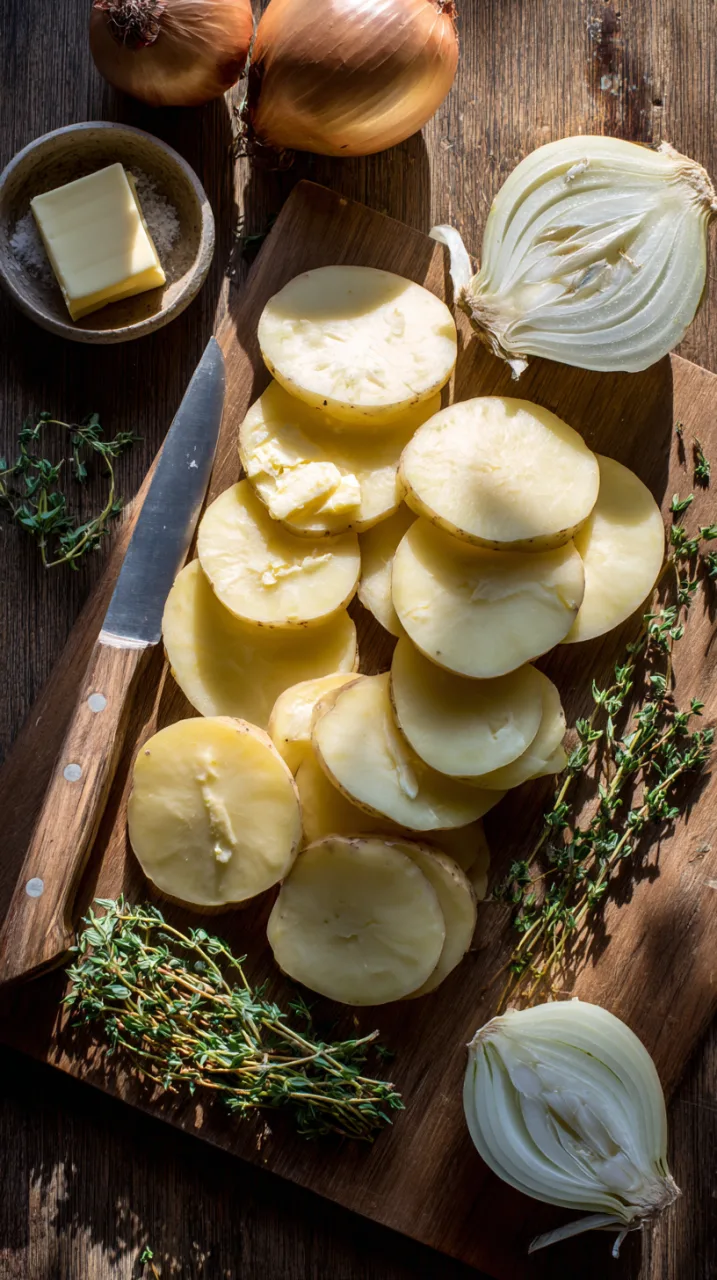
Potatoes. Yukon Golds if you can swing it. They feel solid in your hand, heavy for their size, skin smooth with that golden hint underneath. Pick the light ones and you’ll regret it – watery, mealy, break apart too soon. At the Saturday Santa Cruz market I’ll dig through baskets until I find the weighty ones.
Onions. Yellow is the workhorse. Sweet onions when Watsonville fields are in season. Slice them thin, not paper. You want strands that soften, bend, caramelize. Not wisps that vanish into nothing.
Butter. Clarified if you’ve got it, because it won’t burn when the pan’s running hot. At UCSC we mix it with olive oil when cooking for crowds – stretches it further and keeps the kitchen from turning into a smokehouse. At home, I’ll do half and half. Keeps the alarm quiet while still giving you that buttery hit.
Thyme. Not traditional, but it’s mine. I tossed some in once by accident – sprigs fell off the cutting board – and the smell that came off the onions… man. Stuck with it ever since. Subtle, garden-y, not enough to scream “herbs!” but enough to make you close your eyes and nod.
If you ever swap fresh thyme for dried, this guide on the fresh-to-dried herb ratio makes sure the flavor stays balanced.
The Method, the Way It Really Plays Out
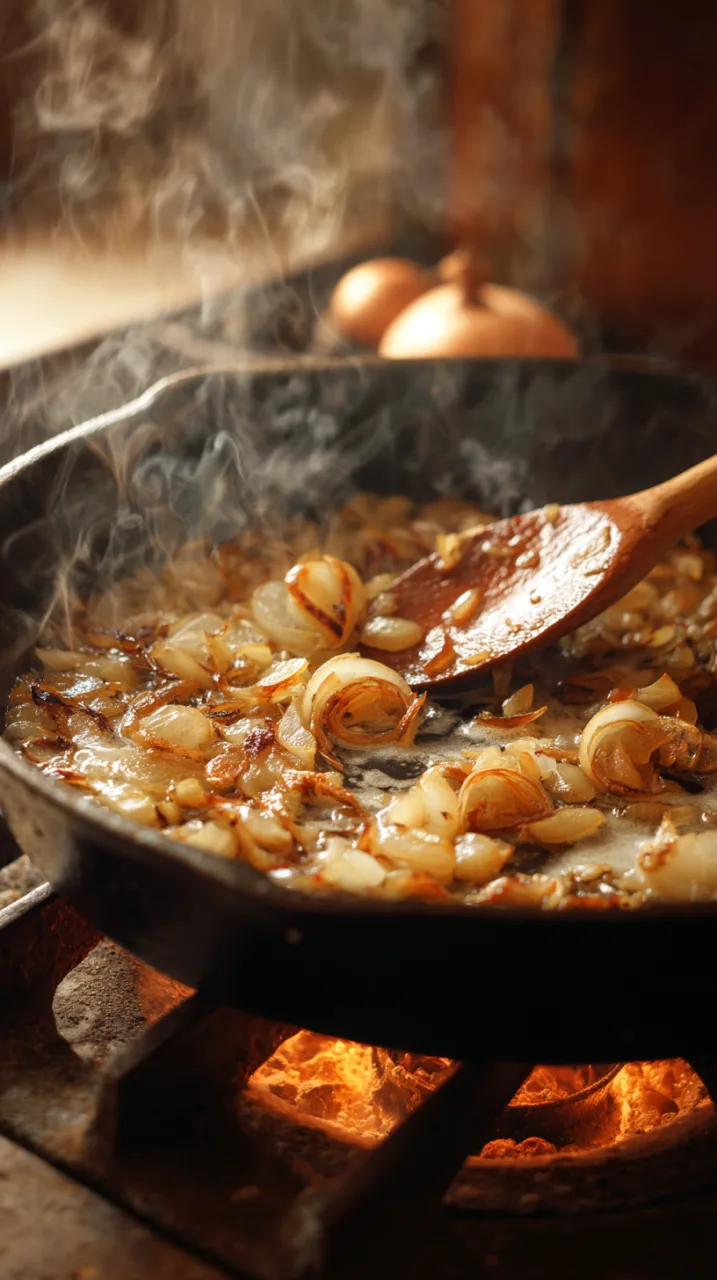
Slice those potatoes a quarter inch thick. Into a pot they go. Cold water, salted like the ocean, splash of vinegar. Bring it up to a simmer, let them go four, maybe five minutes. Just until you can slip a knife in with a little resistance. Pull them out, drain, spread them on a tray. Let steam roll off. I’ll wave a towel over them like I’m shooing flies. Looks ridiculous but dries them faster.
Onions next. Medium heat, not high. Learned that the embarrassing way, pan too hot, onions scorched black before they even softened. Whole kitchen smelled like campfire. Had to start over while one of the cooks muttered, “Chef, you always say low and slow.” Yep. They were right. Ten to fourteen minutes, pinch of salt, maybe a splash of water to scrape up the brown bits. They should smell sweet, not sharp.
Then the potatoes hit the skillet. Heavy pan. Cast iron if you’ve got it. Butter in, it foams, then lay the slices in a single layer. Don’t crowd them, don’t shuffle them, and for the love of God don’t flip them every thirty seconds. Let them sit. It’s torture if you’re impatient. But the crust only comes if you wait. You’ll hear it – that steady rain-on-a-roof crackle. That’s the sign. Flip once. Just once. Gold on the other side, creamy in the middle.
Do them in batches if you have to. No shame in that. Better a couple extra minutes than a pan of soggy stacks. Once they’re all golden, slide the onions back in, toss gently, season with salt and pepper. Off heat, handful of parsley, maybe a whisper of lemon zest or a splash of vinegar. That last hit? Wakes the whole thing up.
Before par-boiling your slices, review this quick primer on mastering the boiling method so they hold their shape in the skillet.
Cooking for Four vs Cooking for Four Hundred
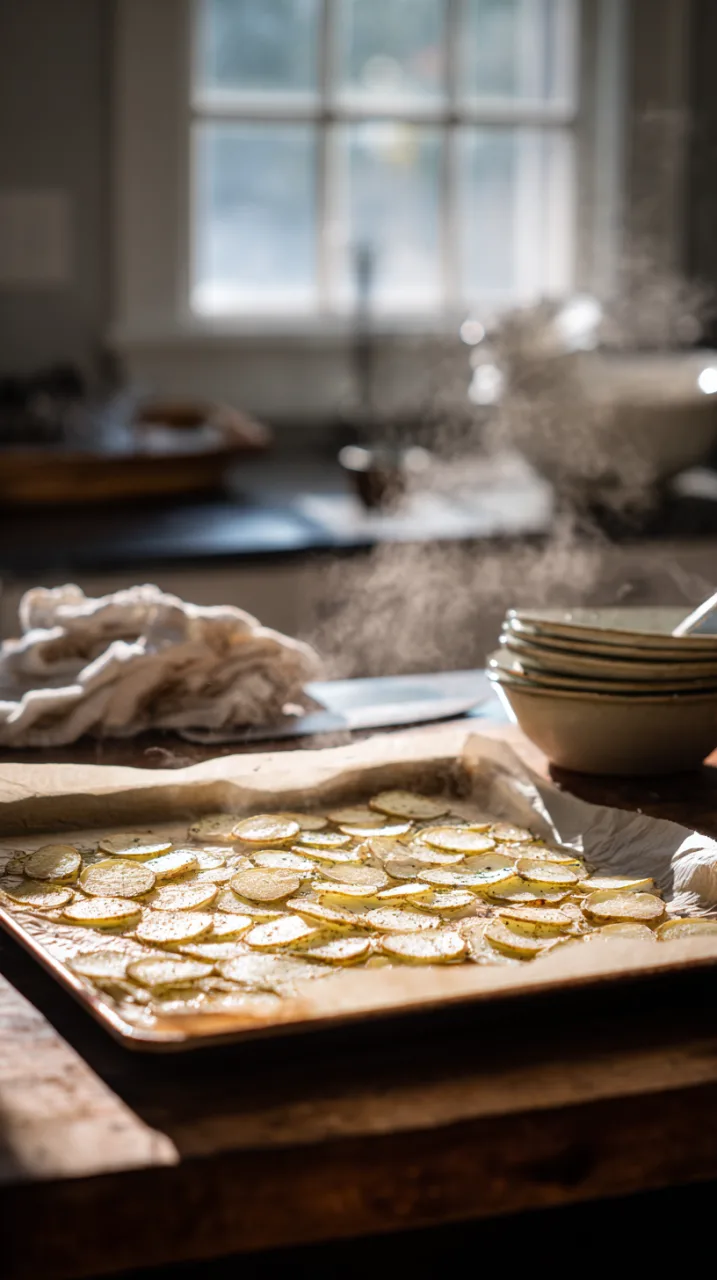
At home, this is easy. One skillet, four servings, ten minutes of standing around while potatoes do their thing.
At my old catering company, we cranked out sixty pounds at a time. Tilt kettles to par-boil, sheet pans to dry, then wave after wave on flat tops. Steam everywhere, spatulas clattering, guests waiting in line. Timing was all steam management. Too wet, and you’ve got mush. Too dry, and they’d crack before crisping. We learned to hold par-boiled potatoes in hotel pans, crisp in shifts, send trays out hot.
Funny thing is, same method, just bigger pans. If it can work at that scale, it’ll never let you down in a home kitchen.
If you’re doubling the recipe for a crowd, this breakdown on how to double a recipe keeps your ratios and timing in check.
How They Hold, and How They Don’t
Here’s the truth: once fried, they don’t reheat worth a damn. Crisp edges soften, onions slump. You can keep them warm in a low oven for half an hour, maybe forty minutes. After that, they turn tired. The pro trick? Par-boil a day early, stash in the fridge, then fry fresh right before serving. That’s how we handle events when timing’s tight.
Nutritional Reality
Look… it’s potatoes and butter. Not diet food. And that’s fine. You get carbs, fat, comfort. Onions count as vegetables but once they’re glazed in butter, call them what they are: flavor delivery. I’ll take a small pile of these over a big plate of steamed broccoli any day.
When measuring fats for frying, this walkthrough on how to measure butter and fats clears up the guesswork.
Swaps and Substitutions I’ve Actually Messed With
Red potatoes: solid texture, a little firmer. Good in a pinch, not as buttery as Yukons.
Russets: fall apart unless you bake them in a casserole. Then it’s not Lyonnaise anymore.
Butter vs oil: butter tastes better, oil behaves better. I mix. Always have. Avocado oil for more neutral flavor
Parsley: classic. Chives if that’s all you’ve got. Cilantro makes it California. Staff meal approved.
A bright, green side like citrus roasted Brussels sprouts balances the richness of Lyonnaise potatoes beautifully.
Notes from Coastal California
The potatoes I buy at the Saturday market still wear soil on their skins. Those are the ones you want. Same for onions out of Watsonville fields, you can almost taste the sweetness in the air before you slice.
If you’re pouring wine, grab something crisp from Monterey. Albariño, Sauvignon Blanc. Cuts the butter, doesn’t fight the dish. At a wedding reception once, we served Lyonnaise potatoes with roast chicken and Albariño… guests circled back for more potatoes before they touched dessert.
And if you’re plating at home? Scatter a handful of baby arugula over the top. Looks sharp, wilts just enough against the heat, makes you look like you know what you’re doing.
For a fresh finishing touch, drizzle your greens with this zesty lemon-oregano vinaigrette right before serving.
My Lyonnaise Potatoes Recipe
Print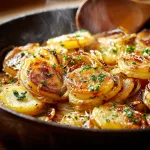
Lyonnaise Potatoes Recipe
- Prep Time: 15 minutes
- Cook Time: 30 minutes
- Total Time: 45 minutes
- Yield: 4 Servings 1x
- Category: Side Dish
- Method: Par-boil, Pan-Fry
- Cuisine: French
Description
Classic French Lyonnaise potatoes are crispy pan-fried rounds layered with sweet golden onions and fresh parsley. This recipe par-boils Yukon Gold potatoes with a splash of vinegar to hold their shape, then finishes them in clarified butter for a deep crust. My twist is adding a little fresh thyme to the onions while they cook. It melts into the onion sweetness and brings a subtle herbal note that makes the dish more aromatic without straying too far from tradition.
Equipment:
- 12-inch cast iron or stainless steel skillet
- Medium saucepan or pot for boiling potatoes
- Colander
- Cutting board and sharp knife
- Wooden spoon or spatula
Ingredients
- 1 1/2 pounds Yukon Gold potatoes, peeled and cut into 1/4-inch slices
- 2 teaspoons kosher salt, plus more to taste
- 1 tablespoon white vinegar (for boiling water)
- 1 large yellow or sweet onion, thinly sliced
- 3 to 4 tablespoons clarified butter (or 2 tablespoons butter + 1 to 2 tablespoons olive oil)
- 1/2 teaspoon fresh thyme leaves (optional but recommended for my version)
- Freshly ground black pepper, to taste
- 2 to 3 tablespoons flat-leaf parsley, chopped
- Optional finish: 1/2 teaspoon white wine vinegar or lemon zest
Instructions
- Place the sliced potatoes in a saucepan and cover with cold water by one inch. Add 2 teaspoons salt and 1 tablespoon white vinegar. Bring to a boil, then reduce to a gentle simmer. Cook for about 4 minutes, until the potatoes are just tender but not falling apart. Drain well and spread the slices on a tray to steam-dry.
- Heat 1 tablespoon clarified butter in the skillet over medium heat. Add the sliced onions with a pinch of salt and the fresh thyme leaves. Cook, stirring often, until the onions are golden and caramelized, 10 to 14 minutes. If they stick, add a splash of water. Transfer onions to a bowl and set aside.
- Wipe out the skillet if needed and add 2 tablespoons clarified butter. Place half the potatoes in a single layer. Cook without moving them until deeply golden on the bottom, about 3 to 5 minutes. Flip once and cook the second side until golden and tender, another 3 to 5 minutes. Transfer to a tray and repeat with remaining potatoes, adding more butter if necessary.
- Return all the potatoes to the pan along with the caramelized onions. Season generously with salt and black pepper. Toss gently for 30 to 60 seconds to combine and heat through.
- Remove from heat and sprinkle with chopped parsley. Add a splash of white wine vinegar or a pinch of lemon zest if you like a little brightness. Serve immediately.
Notes
Traditional Lyonnaise potatoes are made with just potatoes, onions, butter, and parsley. My addition of fresh thyme during the onion stage is a subtle change that makes this recipe stand out. The thyme brings a gentle herbal lift that doesn’t overpower the classic French balance of sweet onions and buttery potatoes. Another difference is finishing with an optional splash of vinegar or lemon zest, which sharpens the flavors and balances the richness. The vinegar in the boiling water is a professional trick that helps the potato slices hold their shape and crisp more reliably.
Nutrition
- Serving Size: 1 Serving
- Calories: 275 kcal
- Sugar: 3 g
- Sodium: 450 mg
- Fat: 14 g
- Saturated Fat: 7 g
- Carbohydrates: 34 g
- Fiber: 4 g
- Protein: 4 g
- Cholesterol: 25 mg
FAQs from My Side of the Stove
Can I freeze them?
Freeze the par-boiled slices. Not the finished dish. Finished ones go grainy.
Do I need a mandoline?
Only if you like cleaning mandolines. Knife works fine.
My potatoes broke apart – why?
Too long in the boil or no vinegar. Both will do it.
Can I bake instead of fry?
Sure, but then it’s gratin. Different dish.
What onion works best?
Yellow or sweet. Red gets bitter and sulky.
Clarified butter really necessary?
No. But it keeps you from burning the pan. Worth it if you’ve got the patience.
How long will they hold on a buffet?
Thirty minutes tops. After that, they sulk. Fry in waves if you want perfection.
The Final Bite
Crisp potatoes, sweet onions, a hit of parsley – it’s the kind of side that disappears before you even sit down.
That’s why I keep it close, the same way I keep a sharp knife or a hot skillet.
If you want more recipes that actually get cooked, not just pinned – I share them every week in the Simply Delicious Newsletter.
I’m Ryan Yates, twenty years on the line, still cooking full-time as an executive chef – and still chasing the perfect potato.

